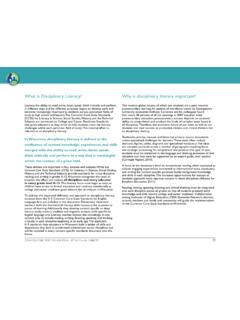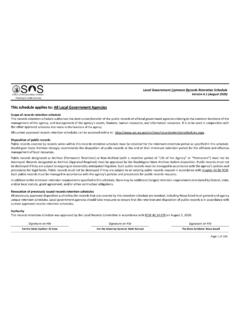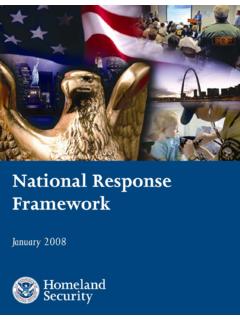Transcription of Get started guide for Azure IT operators - .NET Framework
1 Authors and Contributors The following resources contributed to this version of this guide : Author Neil Peterson | Microsoft Senior Content Developer Contributors and Reference Content Robin Shahan | Microsoft Senior Content Developer Michael Collier | Microsoft Senior SDE Microsoft Azure Essentials: Fundamentals of Azure , Second Edition Summary The purpose of this document is to provide information that will help quickly get started using Azure services. The target audience is those in an IT operator role. 2016 Microsoft. All rights reserved. This document is for informational purposes only. Microsoft makes no warranties, express or implied, with respect to the information presented here. Get started guide for Azure IT operators Contents Introduction to cloud computing and Microsoft Azure .. 3 Cloud computing overview .. 3 Types of cloud computing.
2 4 SaaS: Software as a service .. 4 PaaS: Platform as a 4 IaaS: Infrastructure as a 4 Azure 5 Compute services .. 5 Data services .. 5 Application services .. 5 Network services .. 5 Azure key 6 Datacenters and regions .. 6 Azure 6 Resources .. 6 resource groups .. 6 resource Manager templates .. 6 Automation .. 7 Azure PowerShell .. 7 Azure command-line interface .. 7 REST APIs .. 7 Getting started with Azure subscriptions .. 8 Select and enable an Azure subscription .. 8 Grant administrative access to an Azure subscription .. 9 View billing information in the Azure portal .. 9 Get billing information from billing 9 Forecast cost with the pricing calculator .. 9 Set up billing alerts .. 9 Azure resource 10 Tips for creating resource 10 Building resource Manager templates .. 11 Security of Azure resources (RBAC) .. 12 Azure Virtual 13 Use cases .. 13 Deployment of virtual machines.
3 13 Portal .. 13 14 Command-line interface .. 14 Access and security for virtual machines .. 14 Azure Storage .. 15 Use cases .. 16 Blob storage .. 16 File storage .. 16 Table storage .. 17 Queue storage .. 17 Deploying a storage account .. 17 Portal .. 17 17 Command-line interface .. 18 Access and security for Azure 19 Virtual machine disks .. 19 Storage tools .. 19 Storage API .. 19 Storage access 19 Shared access signatures .. 19 Azure Virtual Network .. 20 Use cases .. 20 Cloud-only virtual networks .. 20 Cross-premises virtual networks .. 20 Deploying a virtual network .. 20 Portal .. 20 20 Command-line interface .. 21 Access and security for virtual networks .. 21 This guide introduces core concepts related to the deployment and management of a Microsoft Azure infrastructure. If you are new to cloud computing, or Azure itself, this guide will help get you quickly started with concepts, deployment, and management details.
4 Many sections of this guide discuss an operation such as deploying a virtual machine, and then provide a link for in-depth technical detail. Introduction to cloud computing and Microsoft Azure Cloud computing overview Cloud computing provides a modern alternative to the traditional on-premises datacenter. Public cloud vendors provide and manage all computing infrastructure and the underlying management software. These vendors provide a wide variety of cloud services. A cloud service in this case might be a virtual machine, a web server, or cloud-hosted database engine. As a cloud provider customer, you lease these cloud services on an as-needed basis. In doing so, you convert the capital expense of hardware maintenance into an operational expense. A cloud service also provides these benefits: Rapid deployment of large compute environments Rapid deallocation of systems that are no longer required Easy deployment of traditionally complex systems like load balancers Ability to provide flexible compute capacity or scale when needed More cost-effective computing environments Access from anywhere with a web-based portal or programmatic automation Cloud-based services to meet most compute and application needs With on-premises infrastructure, you have complete control over the hardware and software that is deployed.
5 Historically, this has led to hardware procurement decisions that focus on scaling up. An example is purchasing a server with more cores to satisfy peak performance needs. Unfortunately, this infrastructure might be underutilized outside a demand window. With Azure , you can deploy only the infrastructure that you need, and adjust this up or down at any time. This leads to a focus on scaling out through the deployment of additional compute nodes to satisfy a performance need. Although this has consequences for the design of an appropriate software architecture, there is now ample proof that scaling out the commodity of cloud services is more cost-effective than scaling up through expensive hardware. Microsoft has deployed many Azure datacenters around the globe, with more planned. Additionally, Microsoft is increasing sovereign clouds in regions like China and Germany.
6 Only the largest global enterprises can deploy datacenters in this manner, so using Azure makes it easy for enterprises of any size to deploy their services close to their customers. For small businesses, Azure allows for a low-cost entry point, with the ability to scale rapidly as demand for compute increases. This prevents a large up-front capital investment in infrastructure, and it provides the flexibility to architect and re-architect systems as needed. The use of cloud computing fits well with the scale-fast and fail-fast model of startup growth. For more information on the available Azure regions, see Azure regions. Types of cloud computing Cloud computing is usually classified into three categories: SaaS, PaaS, and IaaS. SaaS: Software as a service SaaS is software that is centrally hosted and managed. It s usually based on a multitenant architecture a single version of the application is used for all customers.
7 It can be scaled out to multiple instances to ensure the best performance in all locations. SaaS software typically is licensed through a monthly or annual subscription. Microsoft Office 365 is a prototypical model of a SaaS offering. Subscribers pay a monthly or annual subscription fee, and they get Microsoft Exchange as a service (online and/or desktop Microsoft Outlook), storage as a service (Microsoft OneDrive), and the rest of the Microsoft Office suite (online, the desktop version, or both). Subscribers always get the most recent version. So you can have an Exchange server without having to purchase a server and install and support Exchange the Exchange server is managed for you. Compared to installing and upgrading Office every year, this is much less expensive and requires much less effort to keep updated. PaaS: Platform as a service With PaaS, you deploy your application into an application-hosting environment that the cloud service vendor provides.
8 The developer provides the application, and the PaaS vendor provides the ability to deploy and run it. This frees developers from infrastructure management so they can focus on development. Azure provides several PaaS compute offerings, including the Web Apps feature of Azure App Service and Azure Cloud Services (web and worker roles). In either case, developers have multiple ways to deploy their application without knowing anything about the nuts and bolts that support it. Developers don t have to create virtual machines (VMs), use Remote Desktop Protocol (RDP) to sign in to each one, or install the application. They just hit a button (or close to it), and the tools provided by Microsoft provision the VMs and then deploy and install the application on them. IaaS: Infrastructure as a service An IaaS cloud vendor runs and manages all physical compute resources and the required software to enable computer virtualization.
9 A customer of this service deploys virtual machines in these hosted datacenters. Although the virtual machines are located in an offsite datacenter, the IaaS consumer has control over the configuration and management of them. Azure includes several IaaS solutions, including Azure Virtual Machines, virtual machine scale sets, and related networking infrastructure. Azure Virtual Machines is a popular choice for initially migrating services to Azure because it enables a lift and shift migration model. You can configure a VM like the infrastructure currently running your services in your datacenter, and then migrate your software to the new VM. You might need to make configuration updates, such as URLs to other services or storage, but you can migrate many applications in this way. Virtual machine scale sets are built on top of Azure Virtual Machines and provide an easy way to deploy clusters of identical VMs.
10 Virtual machine scale sets also support autoscaling so that new VMs can be deployed automatically when required. This makes virtual machine scale sets an ideal platform to host higher-level microservice compute clusters, such as Azure Service Fabric and Azure Container Service. Azure services Azure offers many services in its cloud computing platform. These services include the following. Compute services Services for hosting and running application workload: Azure Virtual Machines both Linux and Windows App Services (Web Apps, Mobile Apps, Logic Apps, API Apps, and Function Apps) Azure Batch (for large-scale parallel and batch compute jobs) Azure RemoteApp Azure Service Fabric Azure Container Service Data services Services for storing and managing data: Azure Storage (comprises the Azure Blob, Queue, Table, and File services) Azure SQL Database Azure DocumentDB Microsoft Azure StorSimple Azure Redis Cache Application services Services for building and operating applications.







